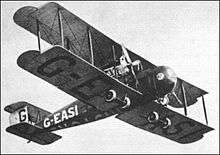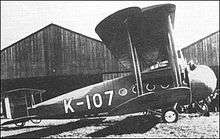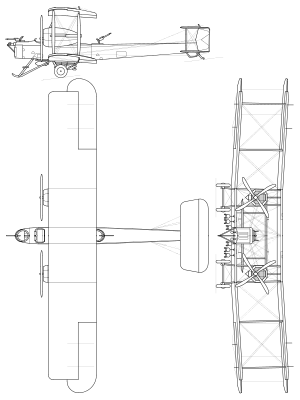Vickers Vimy
| Vimy | |
|---|---|
 | |
| Role | Heavy bomber |
| Manufacturer | Vickers Limited |
| Designer | Reginald Kirshaw Pierson |
| First flight | 30 November 1917 |
| Introduction | 1919 |
| Retired | 1933 |
| Primary user | Royal Air Force |
| Variants | Vickers Vernon |
The Vickers Vimy was a British heavy bomber aircraft of the First World War and post-First World War era. It achieved success as both a military and civil aircraft, setting several notable records in long-distance flights in the interwar period, the most celebrated of which was the first non-stop crossing of the Atlantic Ocean by Alcock and Brown in June 1919.
Design and development

Reginald Kirshaw "Rex" Pierson, chief designer of Vickers Limited (Aviation Department) in Leighton Buzzard, designed a twin-engine biplane bomber, the Vickers F.B.27 to meet a requirement for a night bomber capable of attacking targets in Germany, a contract being placed for three prototypes on 14 August 1917.[1] Design and production of the prototypes was extremely rapid, with the first flying on 30 November 1917,[2] powered by two 200 hp (150 kW) Hispano Suiza engines. It was named after the Battle of Vimy Ridge.
Owing to engine supply difficulties, the prototype Vimys were tested with a number of different engine types, including Sunbeam Maoris, Salmson 9Zm water-cooled radials, and Fiat A.12bis engines, before production orders were placed for aircraft powered by the 230 hp (170 kW) BHP Puma, 400 hp (300 kW) Fiat, 400 hp (300 kW) Liberty L-12 and the 360 hp (270 kW) Rolls-Royce Eagle VIII engines, with a total of 776 ordered before the end of the First World War. Of these, only aircraft powered by the Eagle engine, known as the Vimy IV, were delivered to the RAF.[3] Total Vimy production was 239 aeroplanes of which 134 were built at Brooklands.
Operational history
RAF service
By October 1918, only three aircraft had been delivered to the Royal Air Force, one of which had been deployed to France for use by the Independent Air Force. The war ended, however, before it could be used on operations.[4] The Vimy only reached full service status in July 1919 when it entered service with 58 Squadron in Egypt.[5] The aircraft formed the main heavy bomber force of the RAF for much of the 1920s. The Vimy served as a front line bomber in the Middle East and in the United Kingdom from 1919 until 1925, when it was replaced by the Vickers Virginia, but continued to equip a Special Reserve bomber squadron, 502 Squadron at Aldergrove in Northern Ireland until 1929.[6] The Vimy continued in use as a training aircraft, many being re-engined with Bristol Jupiter or Armstrong Siddeley Jaguar radial engines. The final Vimys, used as Target aircraft for searchlight crews, remained in use until 1938.[7]
Long-distance flights
The Vimy was used in many pioneering flights.
.jpg)
- The most significant was the first non-stop crossing of the Atlantic Ocean by Alcock and Brown in June 1919 (their aircraft is preserved in the London Science Museum);[8]
- In 1919, the Australian government offered £10,000 for the first All-Australian crew to fly an aeroplane from England to Australia. Keith Macpherson Smith, Ross Macpherson Smith and mechanics Jim Bennett and Wally Shiers completed the journey from Hounslow Heath Aerodrome to Darwin via Singapore and Batavia on 10 December 1919 (their aircraft G-EAOU is preserved in a museum in Smith's hometown Adelaide, Australia);[9] "The trip from Darwin to Sydney took almost twice as long as the flight to Australia."[10]
- In 1920, Lieutenant Colonel Pierre van Ryneveld and Major Quintin Brand attempted to make the first England to South Africa flight. They left Brooklands on 4 February 1920 in the Vimy G-UABA named Silver Queen. They landed safely at Heliopolis, but as they continued the flight to Wadi Halfa they were forced to land due to engine overheating with 80 miles (130 km) still to go. A second Vimy was lent to the pair by the RAF at Heliopolis (and named Silver Queen II). This second aircraft continued to Bulawayo in Southern Rhodesia where it was badly damaged when it failed to take off.[9] Van Ryneveld and Brand then used a South African Air Force Airco DH.9 to continue the journey to Cape Town. The South African government awarded them £5,000 each.
Vimy Commercial


The Vimy Commercial was a civilian version with a larger-diameter fuselage (largely of spruce plywood), which was developed at and first flew from the Joyce Green airfield in Kent on 13 April 1919. Initially, it bore the interim civil registration K-107,[11] later being re-registered as G-EAAV.[9]
The prototype entered the 1920 race to Cape Town; it left Brooklands on 24 January 1920 but crashed at Tabora, Tanganyika on 27 February.[9]
A Chinese order for 100 is particularly noteworthy; forty of the forty-three built were delivered to China, but most remained in their crates unused; only seven were put into civilian use.
Fifty-five military transport versions of the Vimy Commercial were built for the RAF as the Vickers Vernon.[12]
Role in the Second Zhili-Fengtian War
After the First Zhili-Fengtian War, 20 aircraft were secretly converted into bombers under the order of the Zhili clique warlord Cao Kun, and later participated in the Second Zhili-Fengtian War.[13]
During the Second Zhili-Fengtian War, these bomber versions of the Vimy Commercial were initially highly successful due to the low-level bombing tactics used, with the air force chief-of-staff of the Zhili clique, General Zhao Buli (趙步壢) personally flying many of the missions. However, on 17 September, returning from a successful bombing mission outside Shanhai Pass, General Zhao's bomber was hit by ground fire from the Fengtian clique in the region of Nine Gates (Jiumenkou, 九門口) and had to make a forced landing. Although General Zhao was able to make a successful escape back to his base, the bombers subsequently flew at much higher altitude to avoid ground fire, which greatly reduced their bombing accuracy and effectiveness.[13]
After numerous battles between Chinese warlords, all of the aircraft fell into the hands of the Fengtian clique, forming its First Heavy Bomber Group.[13] These bombers were in the process of being phased out at the time of the Mukden Incident and therefore were subsequently captured by the Japanese, who soon disposed of them.
Vimy replicas

Apart from a replica transatlantic Vimy cockpit section built by Vickers for the London Science Museum in the early 1920s, three full-size replicas have also been built. The first was a taxiable replica commissioned by British Lion Films from Shawcraft Models Ltd of Iver Heath, Bucks; the planned film about Alcock & Brown's transatlantic flight was never made, but the model was completed and paid for. Its fate remains a mystery[14] although it appeared on static display at the Battle of Britain air display at RAF Biggin Hill in 1955 and may have been subsequently stored dismantled in East London until at least the late 1980s.
In 1969, an airworthy Vimy replica (registered G-AWAU) was built by the Vintage Aircraft Flying Association at Brooklands (this aircraft was first flown by D G 'Dizzy' Addicott and Peter Hoare but was badly damaged by fire that summer and was displayed until February 2014 at the RAF Museum, Hendon, London).[15][16] It is currently stored dismantled by the RAF Museum in Stafford.[15]
A second flyable Vimy replica, NX71MY, was built in 1994 by an Australian-American team led by Lang Kidby and Peter McMillan, and this aircraft successfully recreated the three great pioneering Vimy flights: England to Australia flown by Lang Kidby and Peter McMillan (in 1994),[17] England to South Africa flown by Mark Rebholz and John LaNoue (1999) and in 2005, Alcock and Brown's 1919 Atlantic crossing was recreated, flown by Steve Fossett and Mark Rebholz. The aircraft was donated to Brooklands Museum in 2006 and was kept airworthy in order to commemorate the 90th anniversaries of the Transatlantic and Australian flights until retired in late 2009. Its final flight was made by John Dodd, Clive Edwards and Peter McMillan from Dunsfold to Brooklands on 15 November 2009 and four days later, in just 18 hours, the aircraft was dismantled, transported the short distance to the Museum and reassembled inside the main hangar by a dedicated volunteer team. Two days later a special Brooklands Vimy Exhibition was officially opened by Peter McMillan, and this unique aircraft is now on public display there.
Variants

- F.B.27 Vimy
- Prototypes; four built, powered by two 200 hp (150 kW) Hispano-Suiza 8 piston engines..
- F.B.27A Vimy II
- Twin-engine heavy bomber aircraft for the RAF, powered by two 360 hp (270 kW) Rolls-Royce Eagle VIII piston engines.
- Vimy Ambulance
- Air ambulance version for the RAF.
- Vimy Commercial
- Civilian transport version, powered by two 360 hp (270 kW) Rolls-Royce Eagle VIII piston engines.
- A.N.F. 'Express Les Mureaux'
- Vimy Commercial No.42 re-engined with 2x 370 hp (280 kW) Lorraine 12Da V-12 engines.
Operators
Military operators

- Royal Air Force (Vimy, Vimy Ambulance & Vernon).
Civil operators
- The Government of China (Vimy Commercial).
- Grands Express Aériens (Vimy Commercial).
- One aircraft.
- The Government of Spain (Vimy).
- Imperial Airways (Vimy Commercial).
- Instone Air Line (Vimy Commercial).
Specifications (Vimy)
Data from
General characteristics
- Length: 43 ft 7 in (13.28 m)
- Wingspan: 68 ft 1 in (20.75 m)
- Height: 15 ft 8 in (4.77 m)
- Wing area: 1,330 sq ft (123.56 m²)
- Empty weight: 7,104 lb (3,222 kg)
- Max. takeoff weight: 10,884 lb (4,937 kg)
- Powerplant: 2 × Rolls-Royce Eagle VIII piston engines, 360 hp (268 kW) each
Performance
- Maximum speed: 100 mph (161 km/h)
- Range: 900 mi (1,448 km)
- Service ceiling: 7,000 ft (2,134 m)
- Power/mass: 0.07 hp/lb (0.11 kW/kg)
Armament
- Guns: 1 × .303 in (7.7 mm) Lewis Gun in Scarff ring in nose and 1 × in Scarff ring in mid-fuselage
- Bombs: 2,476 lb (1,123 kg) of bombs
See also
- Related development
- Aircraft of comparable role, configuration and era
References
Notes
- ↑ Jarrett 1992, p. 9.
- ↑ Mason 1994, p. 95.
- ↑ Mason 1994, p. 96.
- ↑ Thetford 1992, p. 32.
- ↑ Andrews and Morgan 1988, p. 90.
- ↑ Mason 1994, p. 98.
- ↑ Andrews and Morgan 1988, p. 93.
- ↑ Jackson 1988, p. 201.
- 1 2 3 4 Jackson 1988, p. 202.
- ↑ "Vickers Vimy." Discover Collections: State Library of NSW. Retrieved: 4 December 2012.
- ↑ Andrews and Morgan 1988, p. 95.
- ↑ "The Vickers "Vimy-Commercial" Biplane." Flight, Volume XI, Issue 29, Np. 551, 17 July 1919, pp. 936–941. Retrieved: 12 January 2011.
- 1 2 3 "我國最早航運機隊主力 -商用維美運輸機"(Vickers Vimy Commercial in Chinese language) sinaman.com. Retrieved: 15 March 2008.
- ↑ Aeroplane magazine, May 2010
- 1 2 "Vickers Vimy replica due to leave RAF Museum". Pilot. 21 February 2014. Retrieved 28 July 2015.
- ↑ Jackson 1988, p. 203.
- ↑ McMillan 1995, pp. 4–43.
Bibliography
- Andrews, C.F. and Eric B. Morgan. Vickers Aircraft since 1908, Second edition. London: Putnam, 1988. ISBN 0-85177-815-1.
- Jackson, A.J. British Civil Aircraft 1919-1972: Volume III. London: Putnam, revised second edition, 1988. ISBN 0-85177-818-6.
- Jarrett, Philip. "By Day and By Night: Part Six." Aeroplane Monthly Volume 20, No. 11, November 1992, pp. 8–14. London: IPC.
- Mason, Francis K. The British Bomber Since 1914. London: Putnam Aeronautical Books, 1994. ISBN 0-85177-861-5.
- McMillan, Peter. "The Vimy Flies Again" National Geographic, Volume 187, No. 5, May 1995, pp. 4–43.
- Thetford, Owen. "By Day and By Night: Part Seven." Aeroplane Monthly, Volume 20, No. 12, December 1992, pp. 30–38. London: IPC.
- Winchester, Jim, ed. "Vickers Vimy." Biplanes, Triplanes and Seaplanes (Aviation Factfile). London: Grange Books plc, 2004. ISBN 1-84013-641-3.
External links
| Wikimedia Commons has media related to Vickers Vimy. |
- The Vickers Vimy-Commercial at Hendon, 1919
- Vickers Vimy preserved at Adelaide, South Australia
- RAF Museum
- Alcock and Brown's aeroplane at the London Science Museum
- Vickers Vimy online collection - State Library of NSW
- The Science Museum,South Kensington: Alcock and Brown's Vickers Vimy biplane, 1919
- National Geographic record of the 2005 re-enactment on the Atlantic flight
